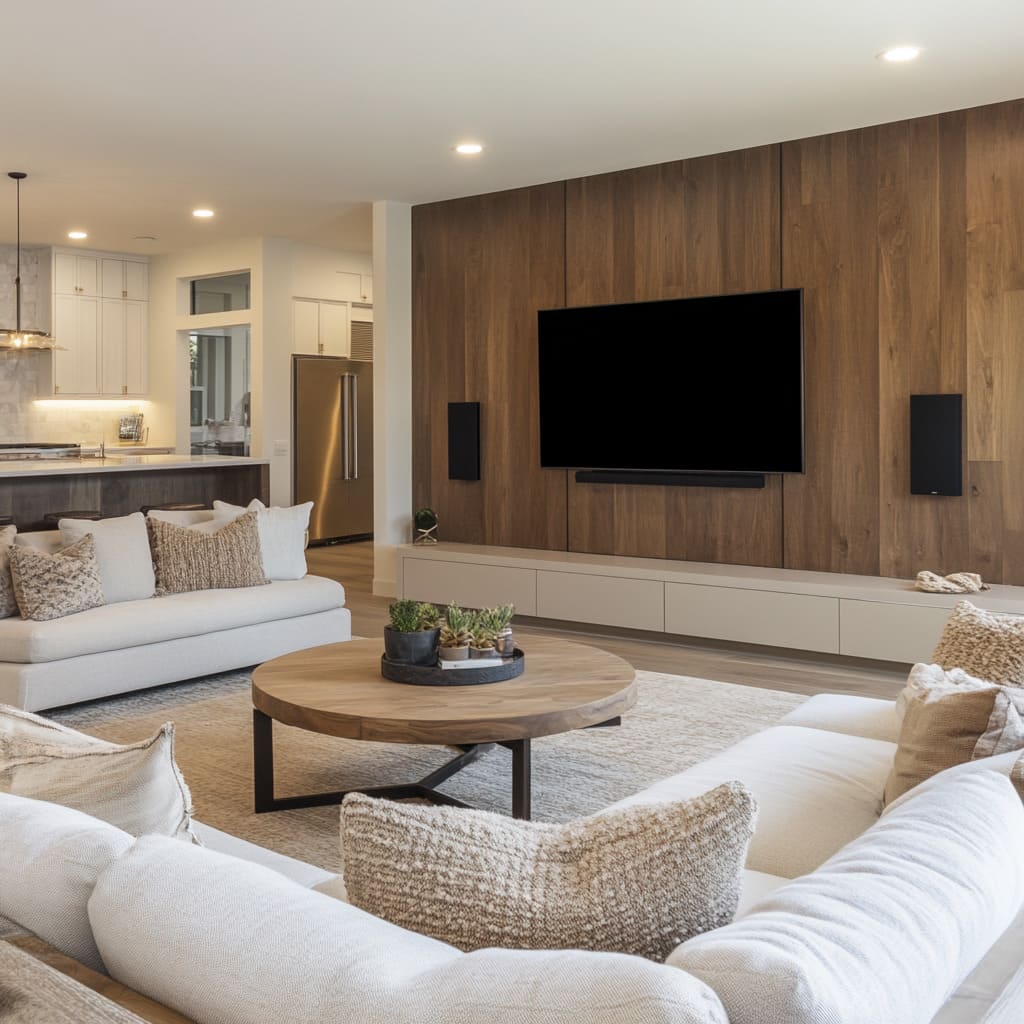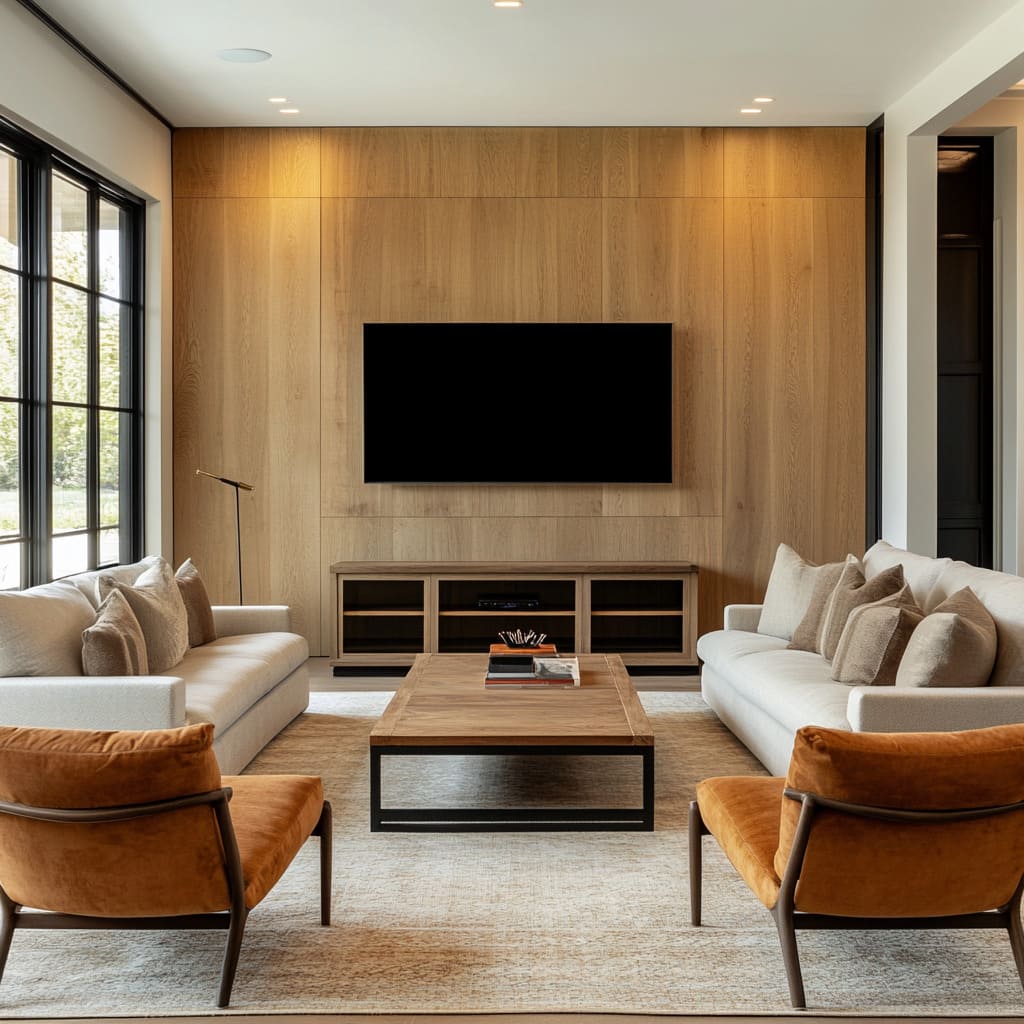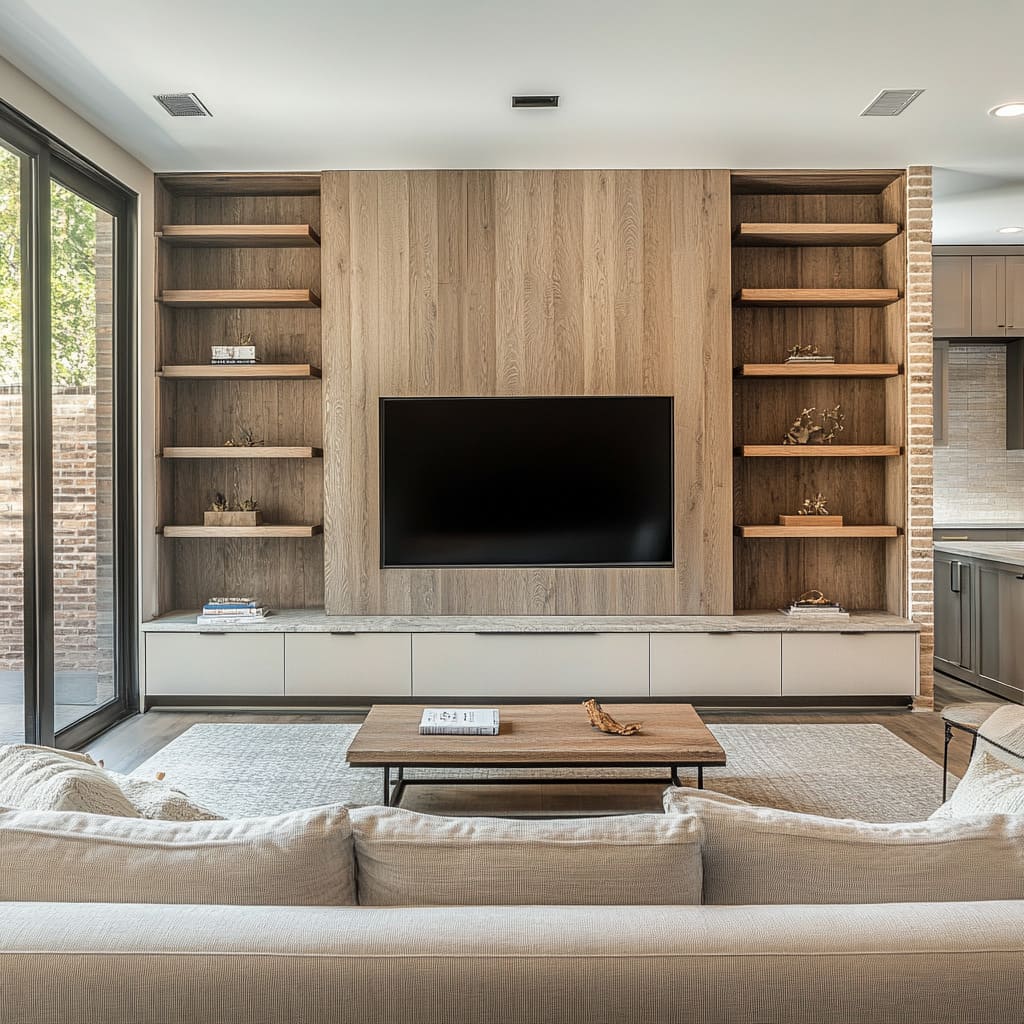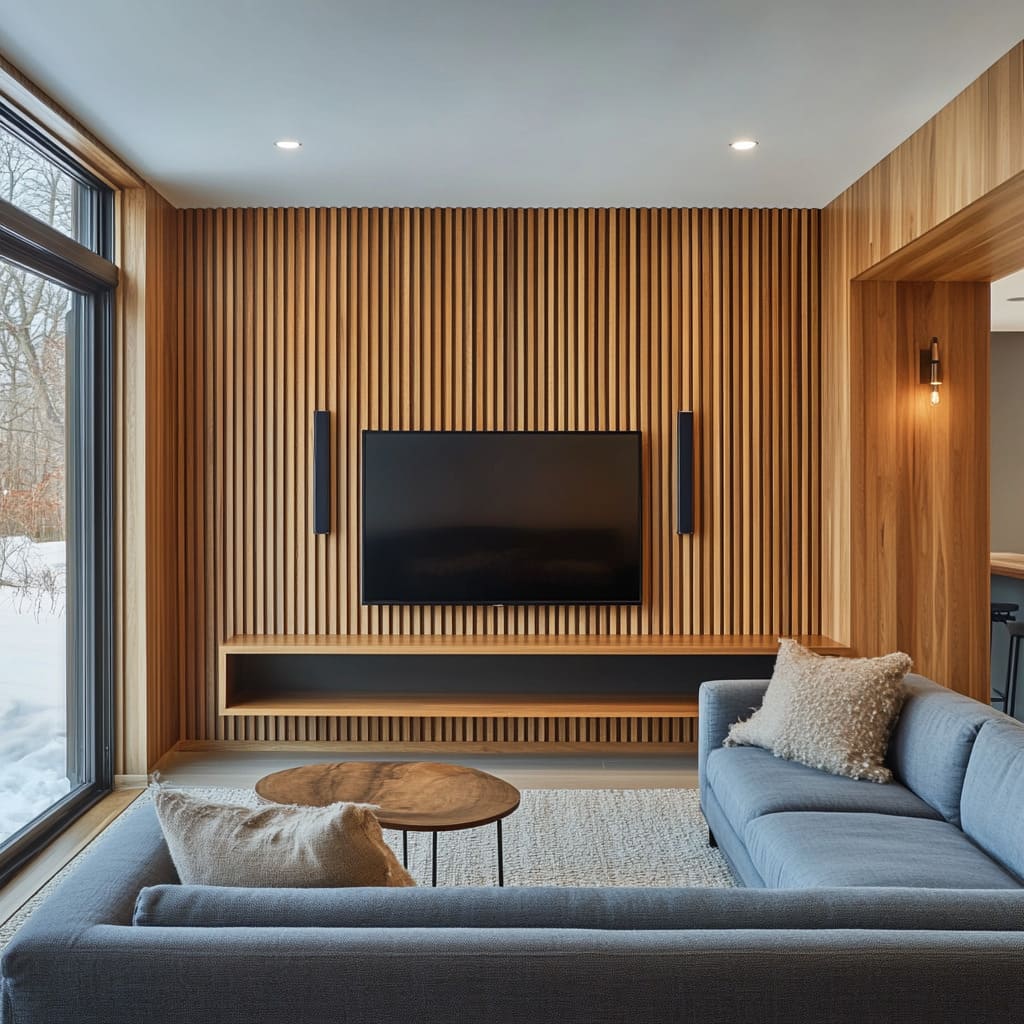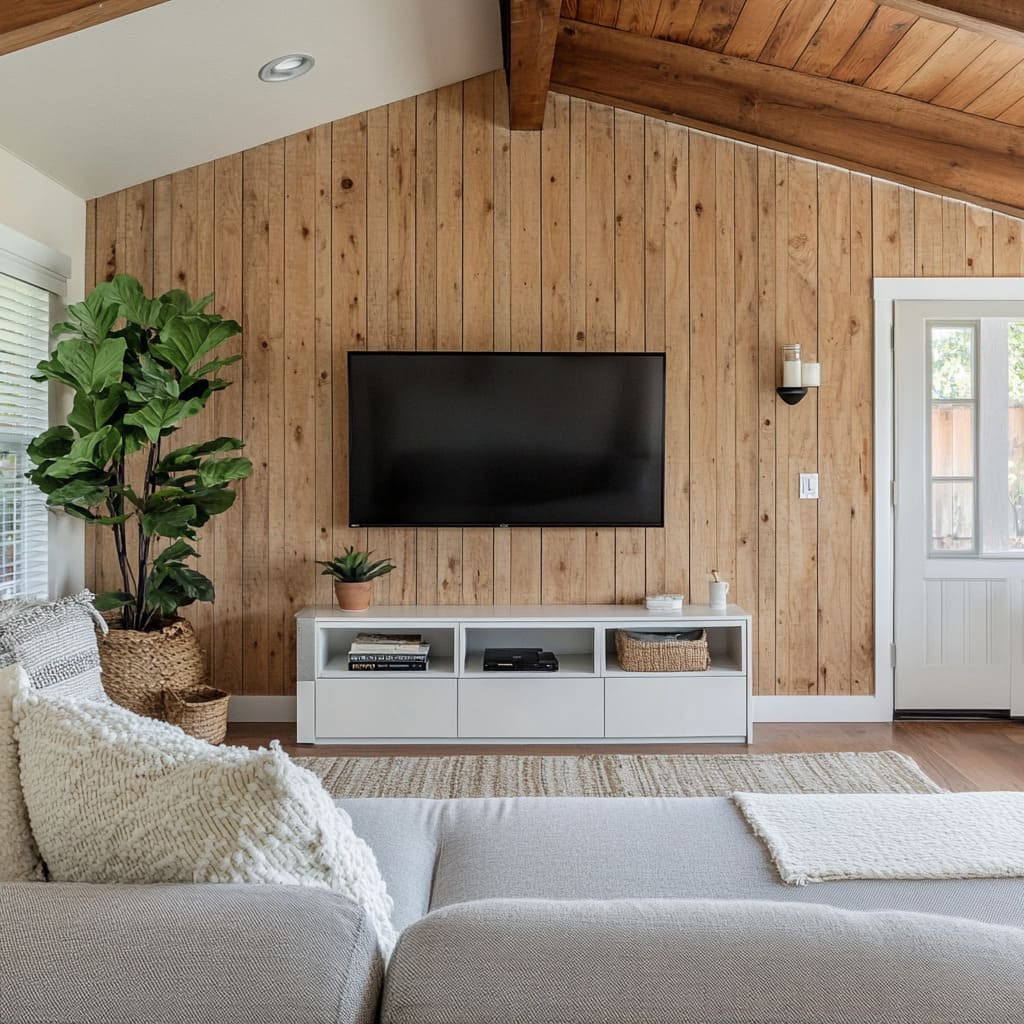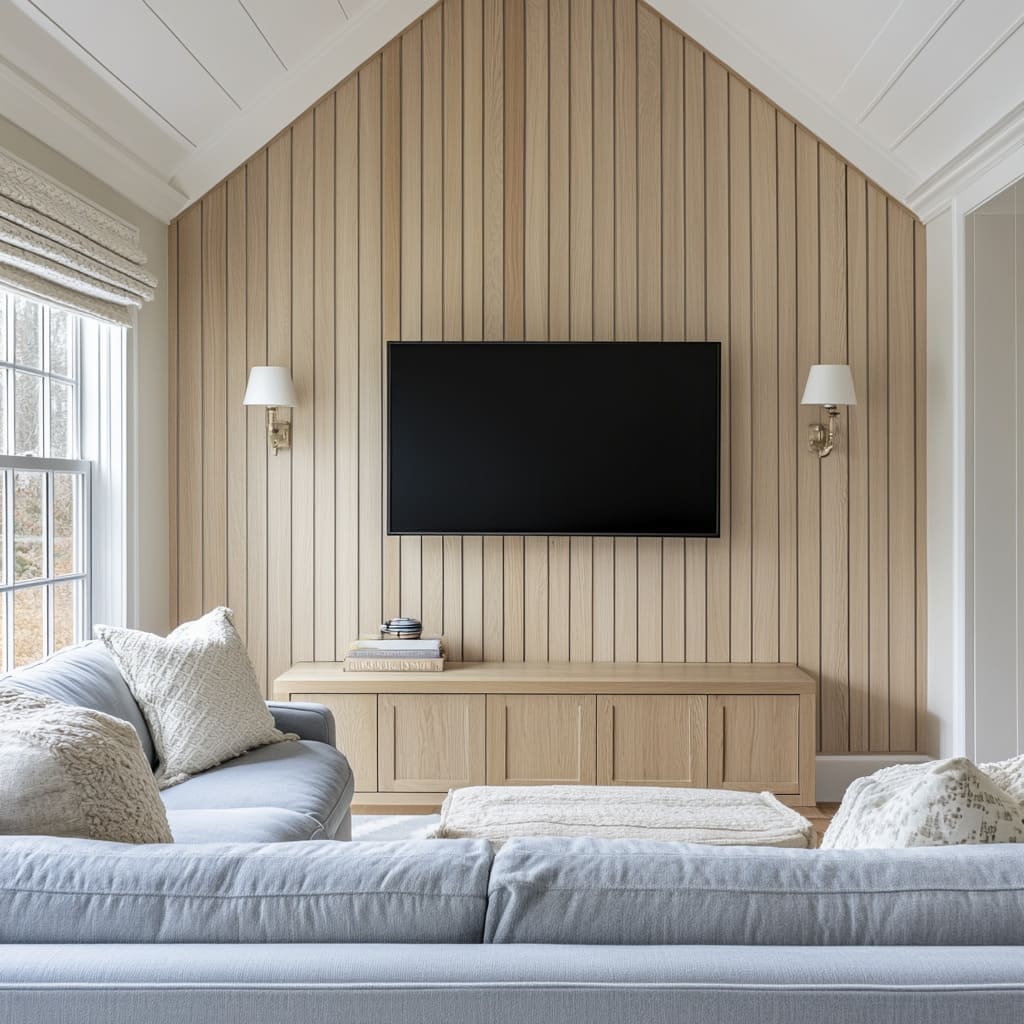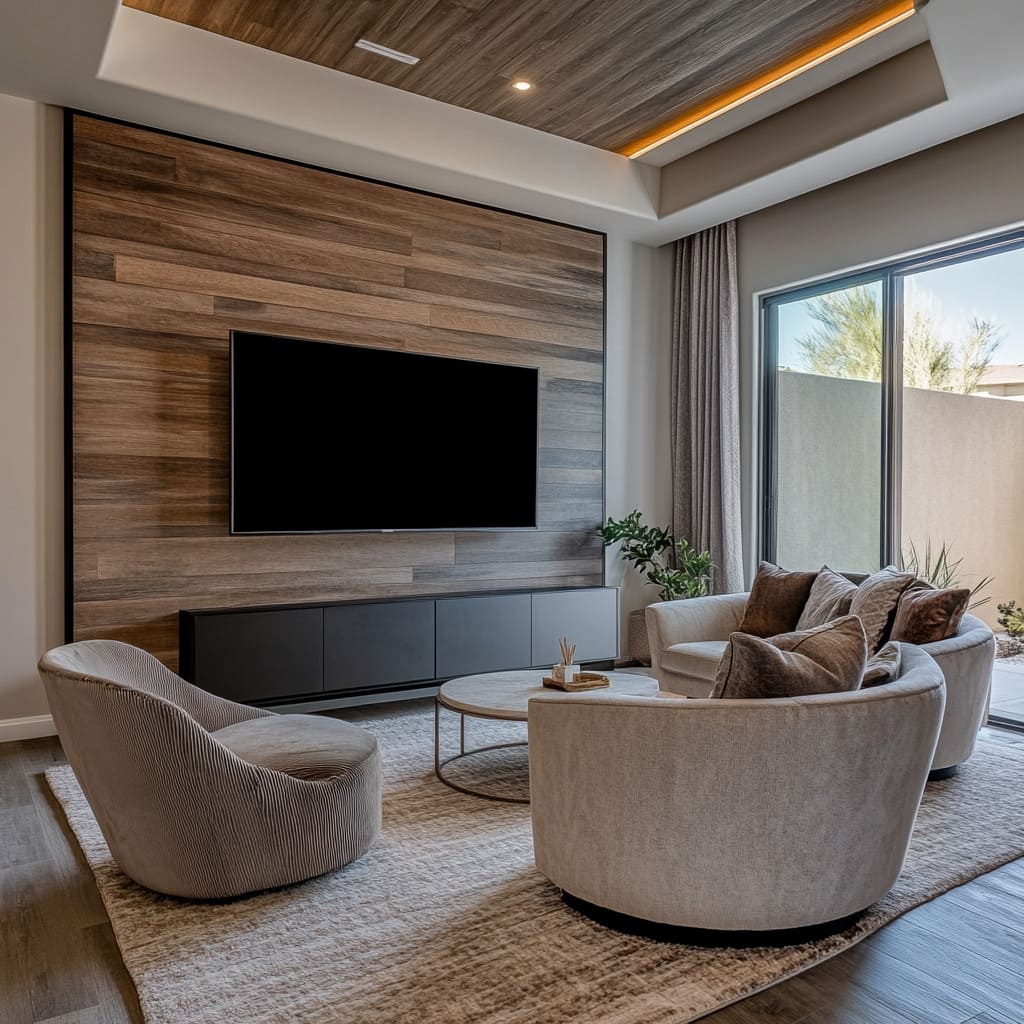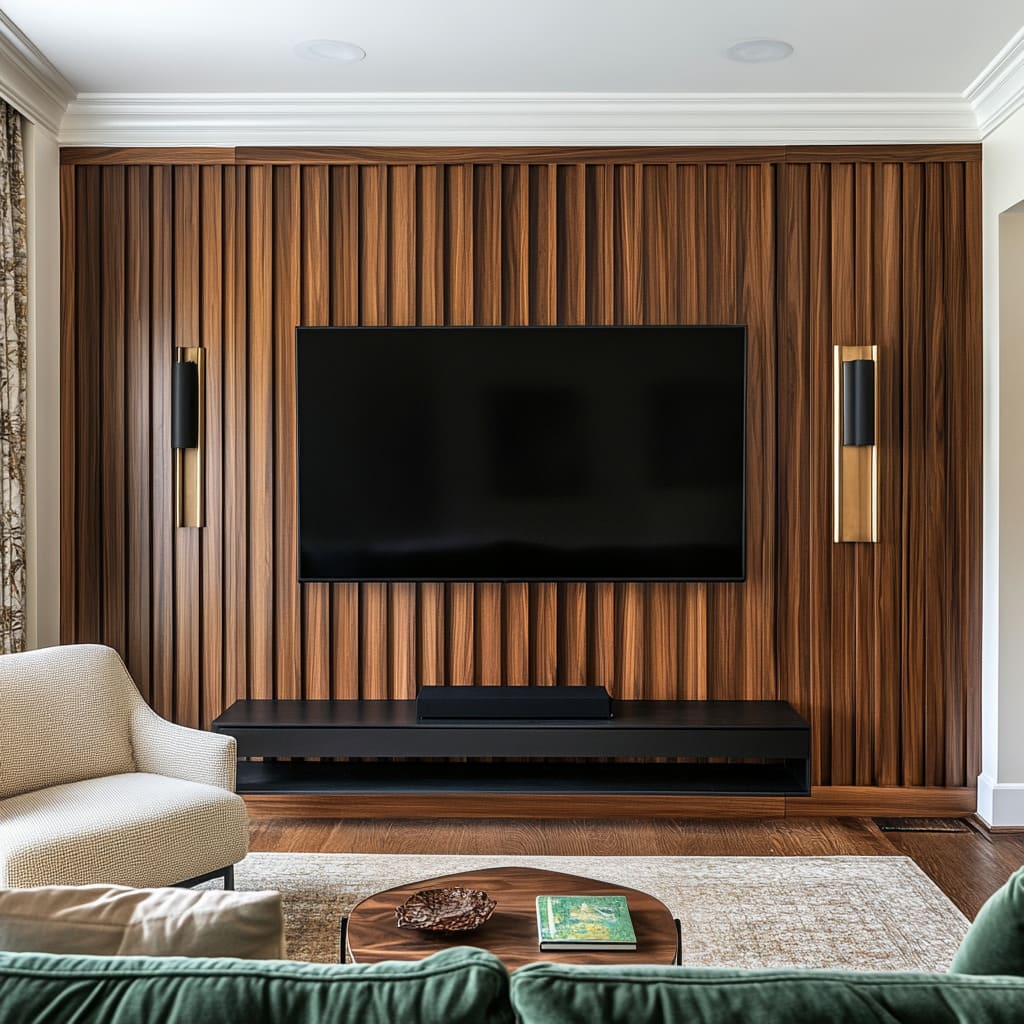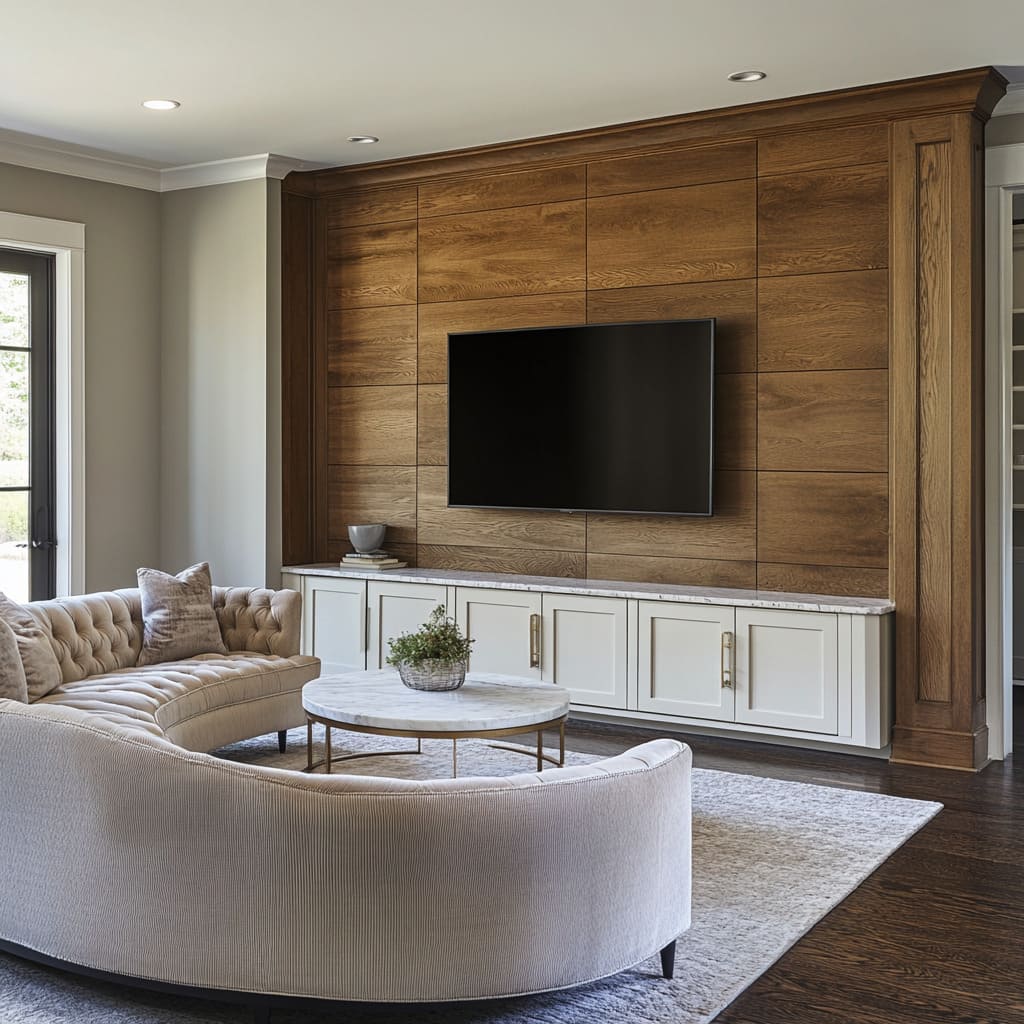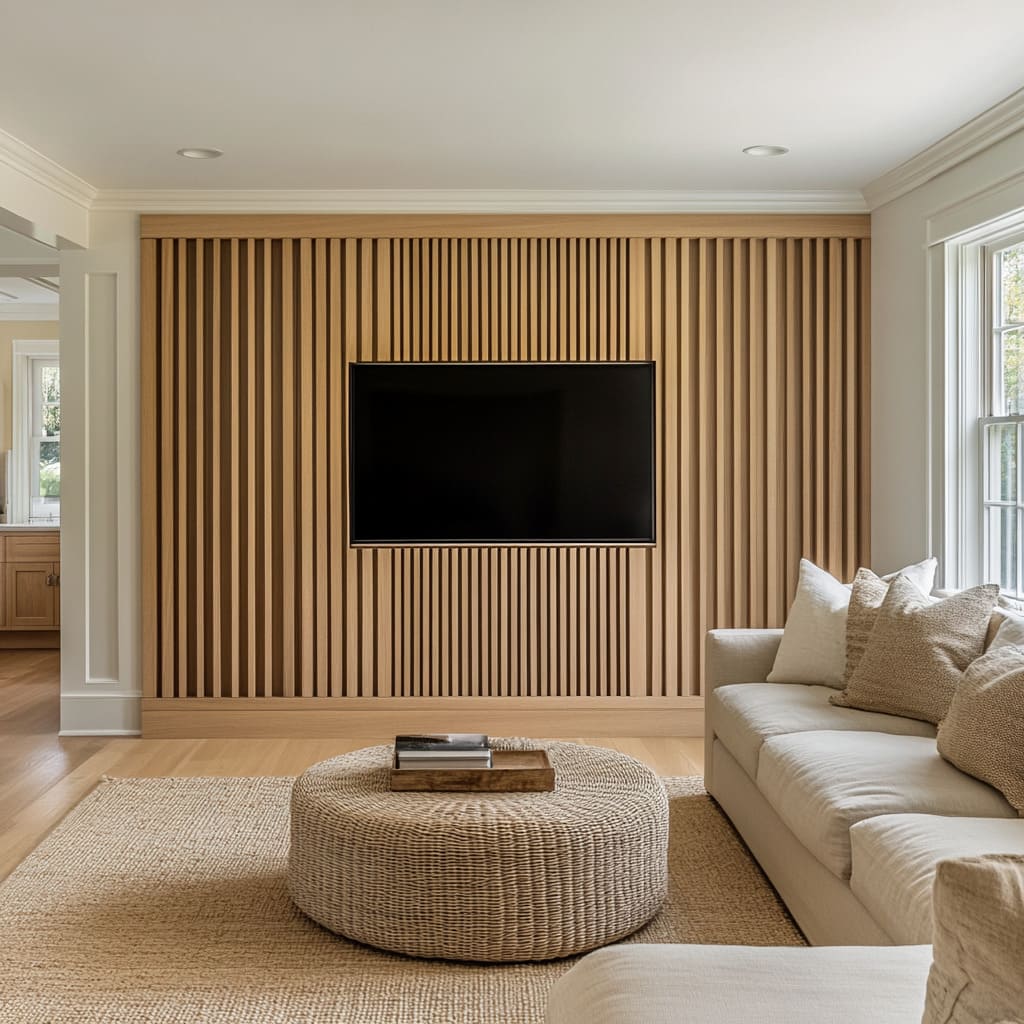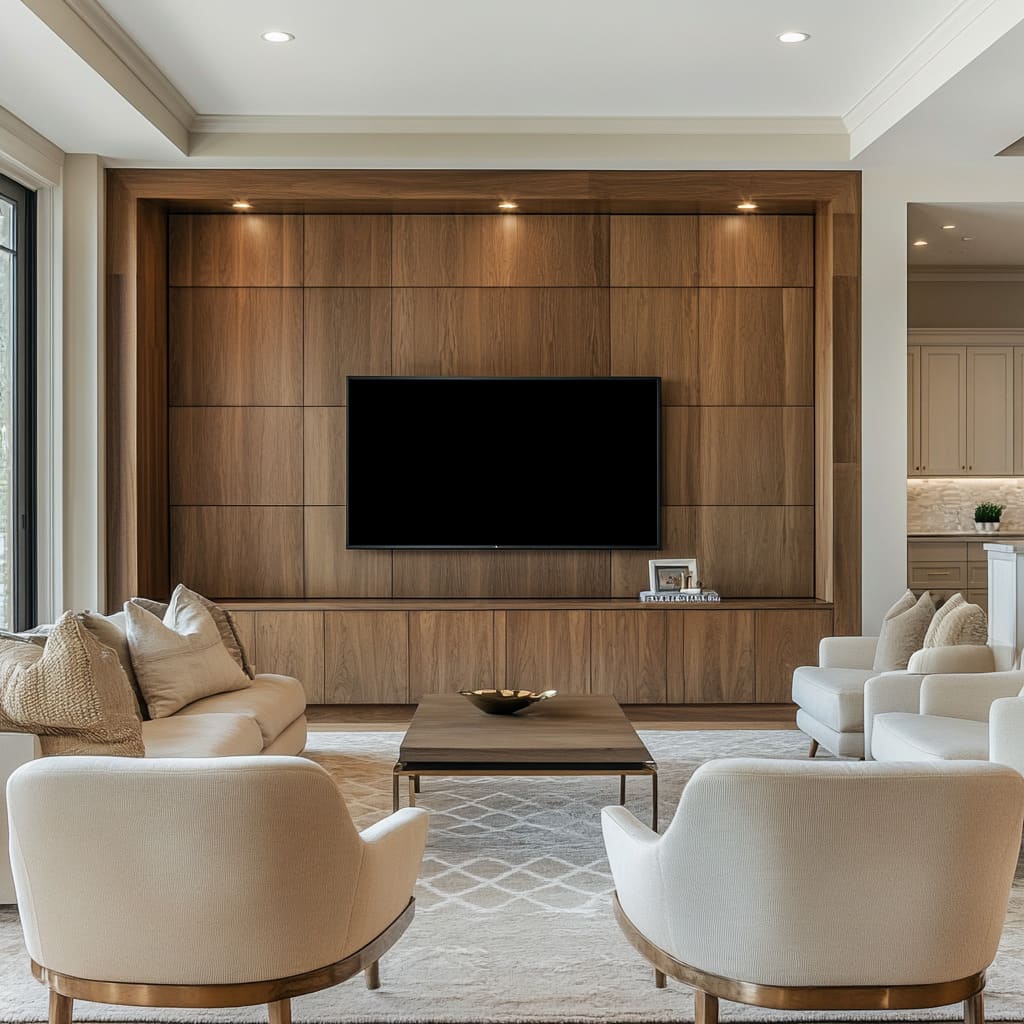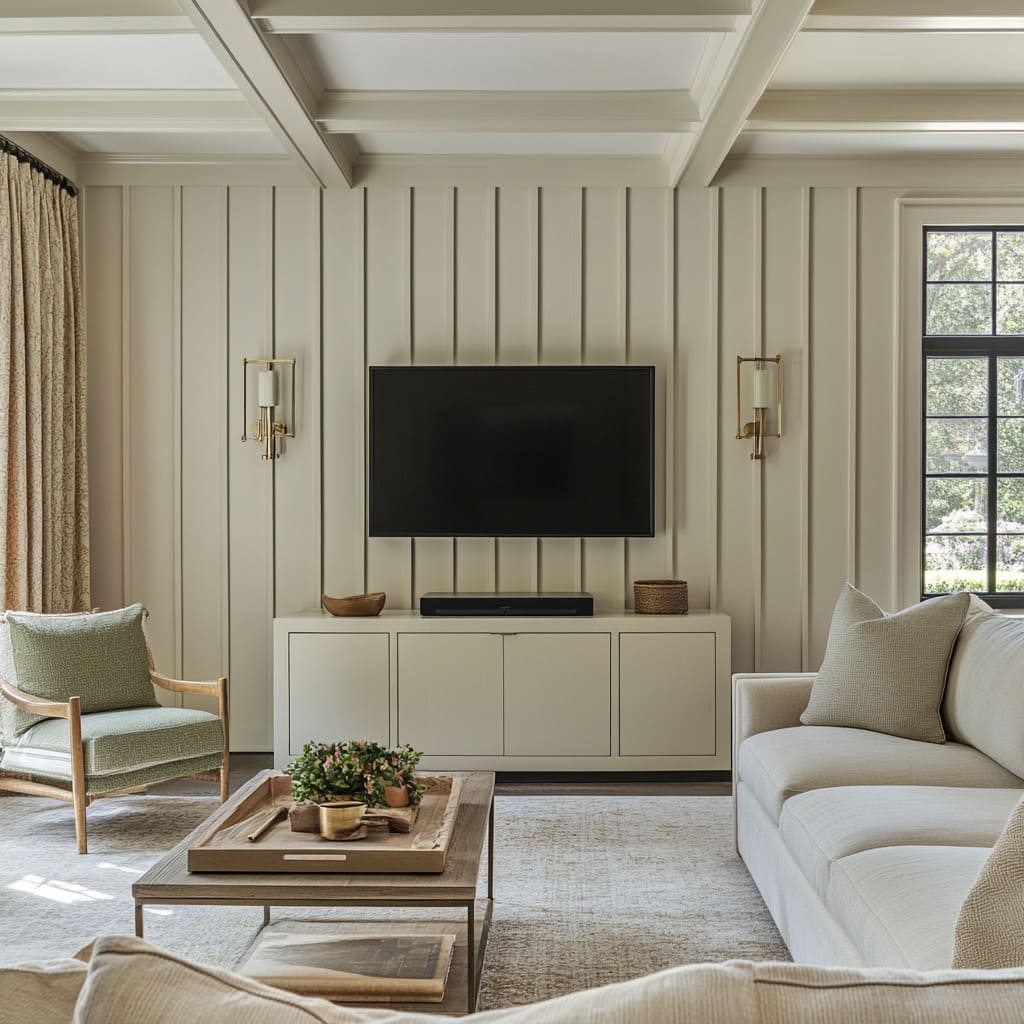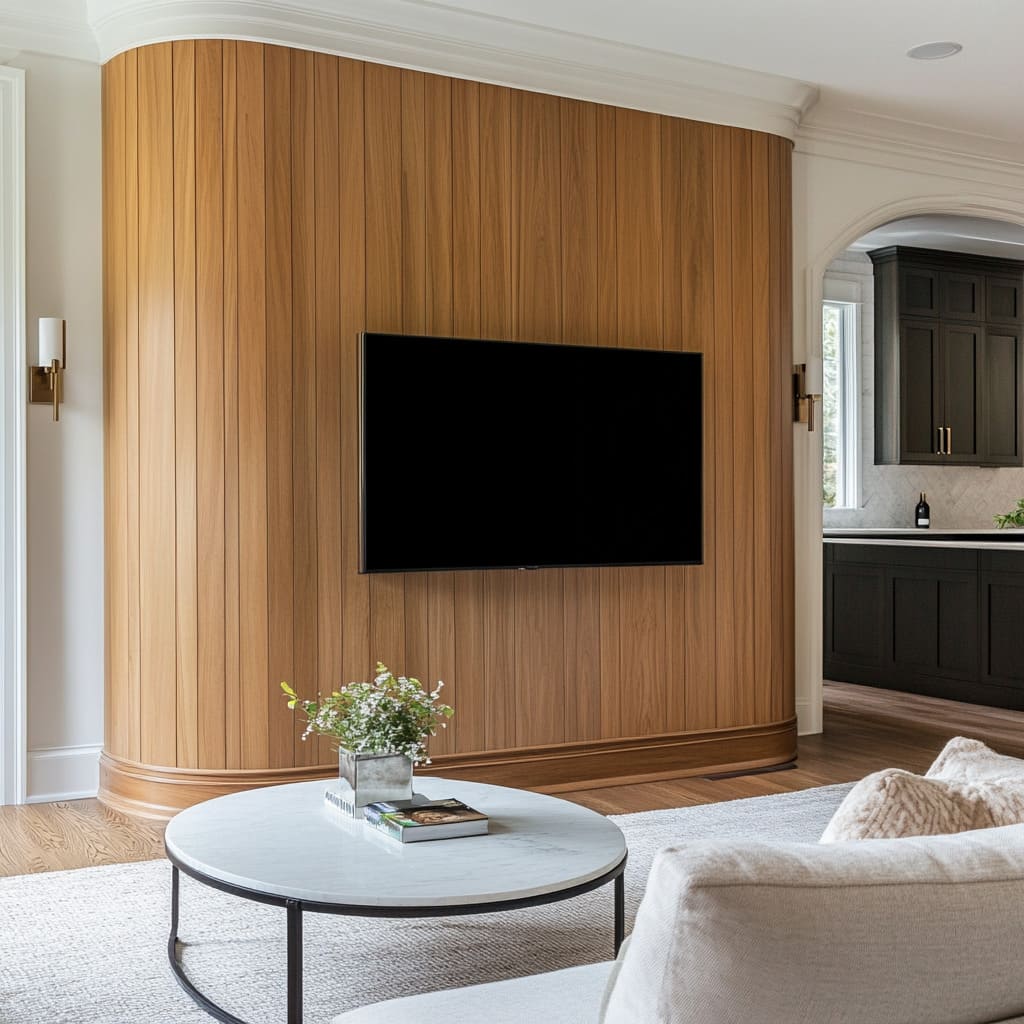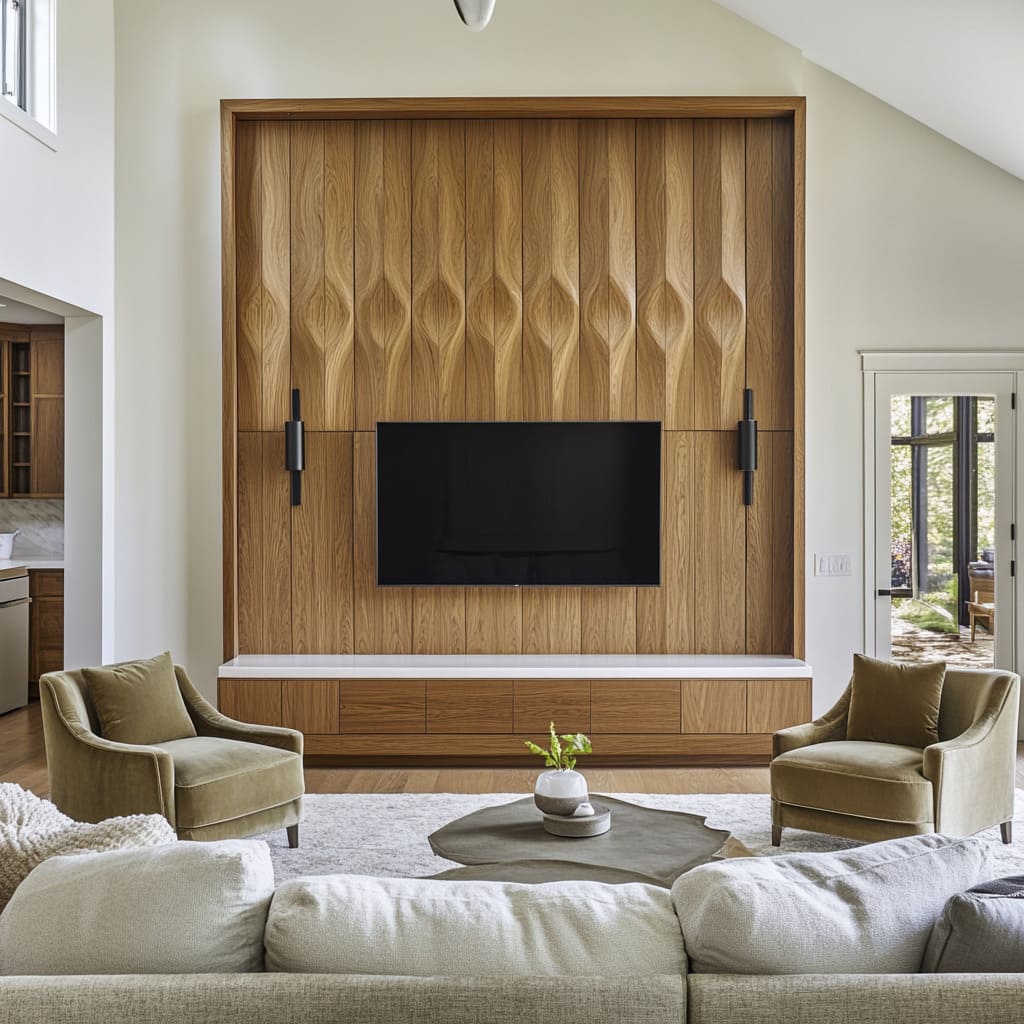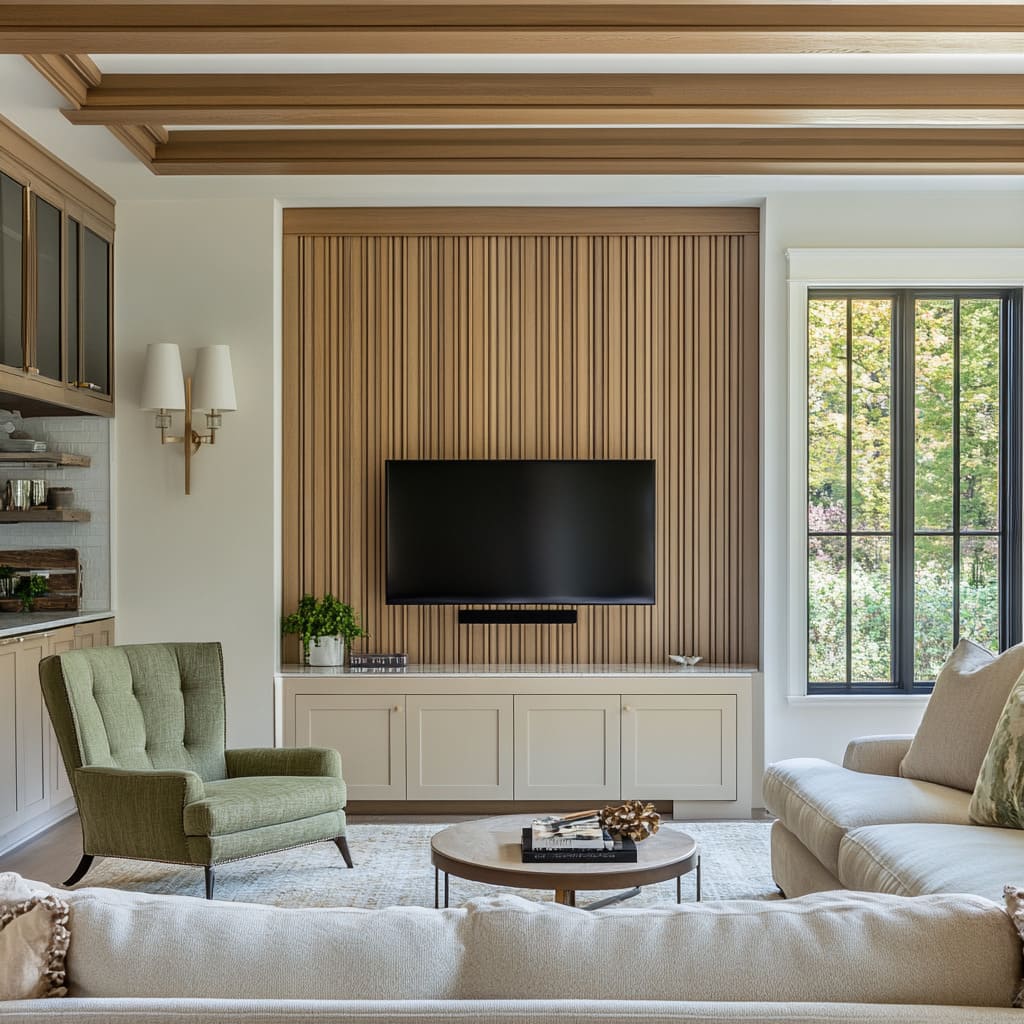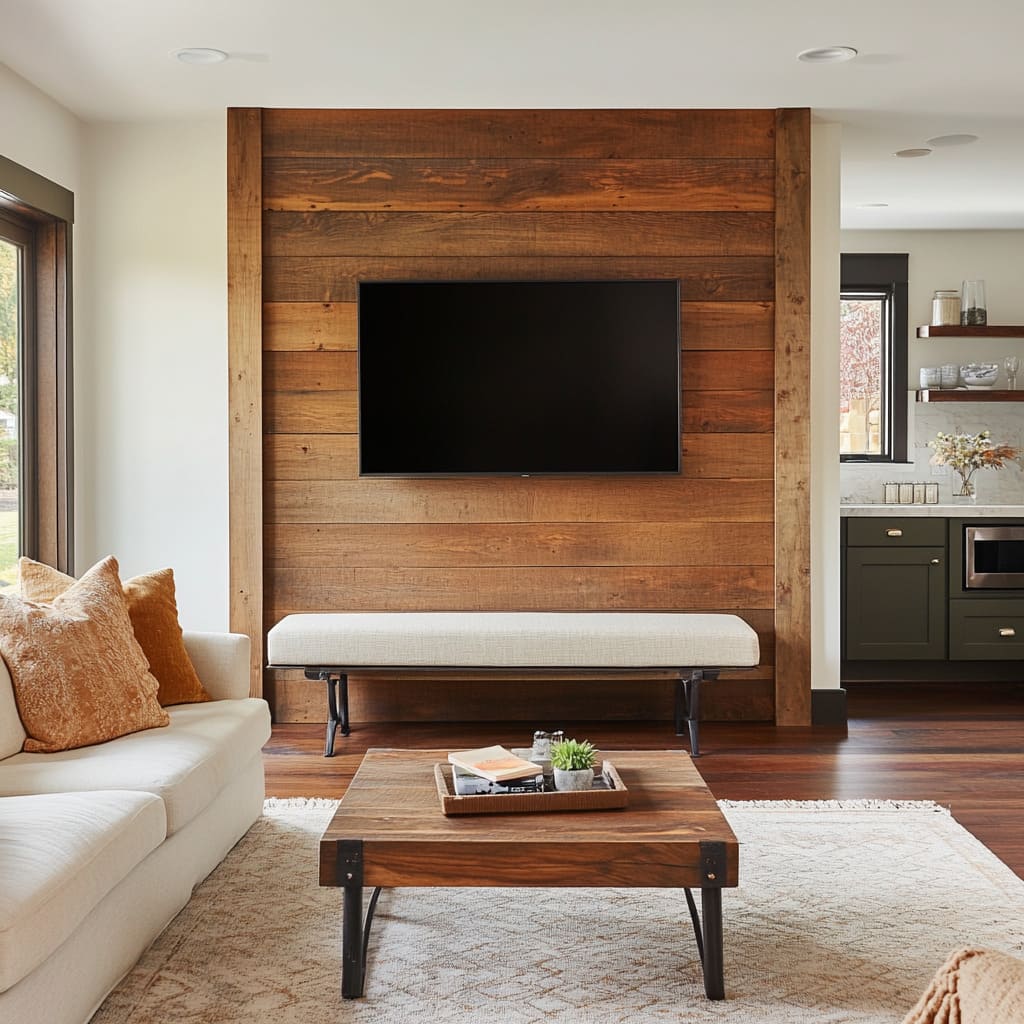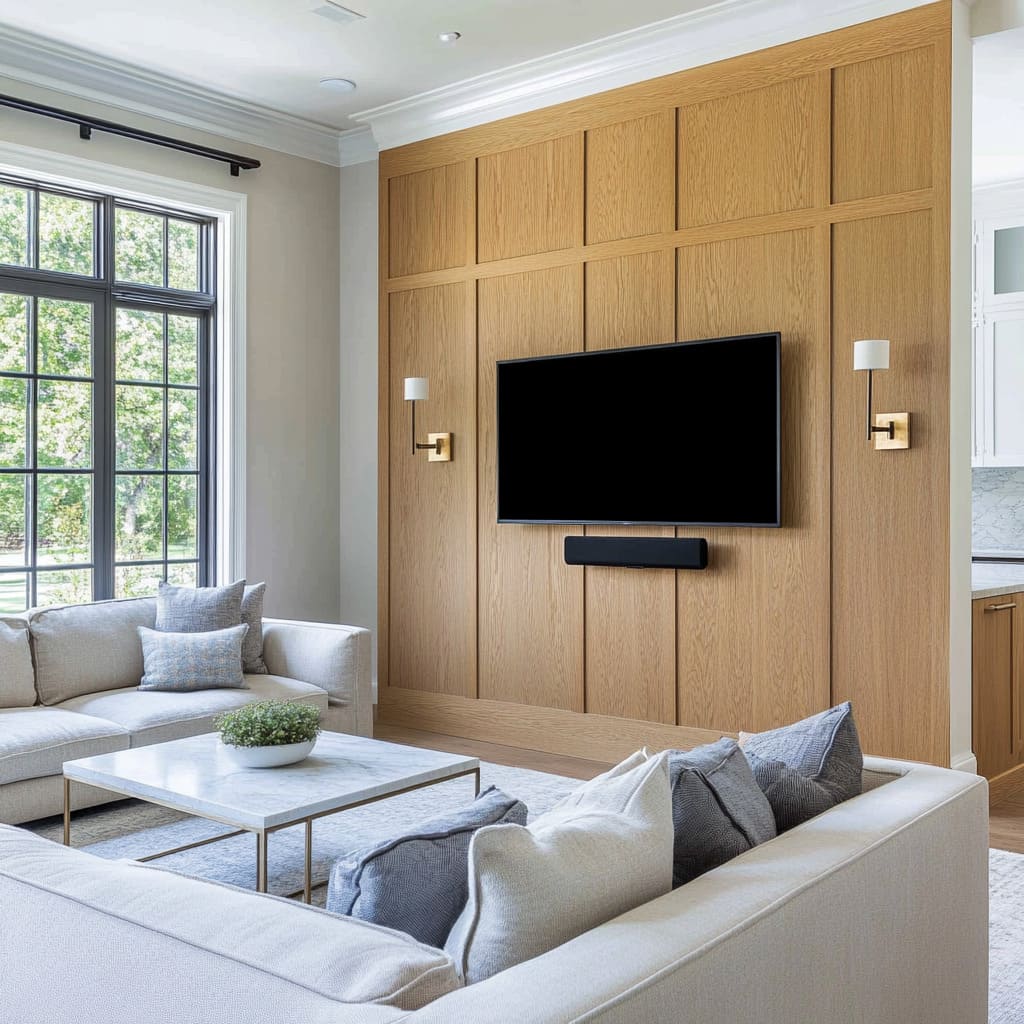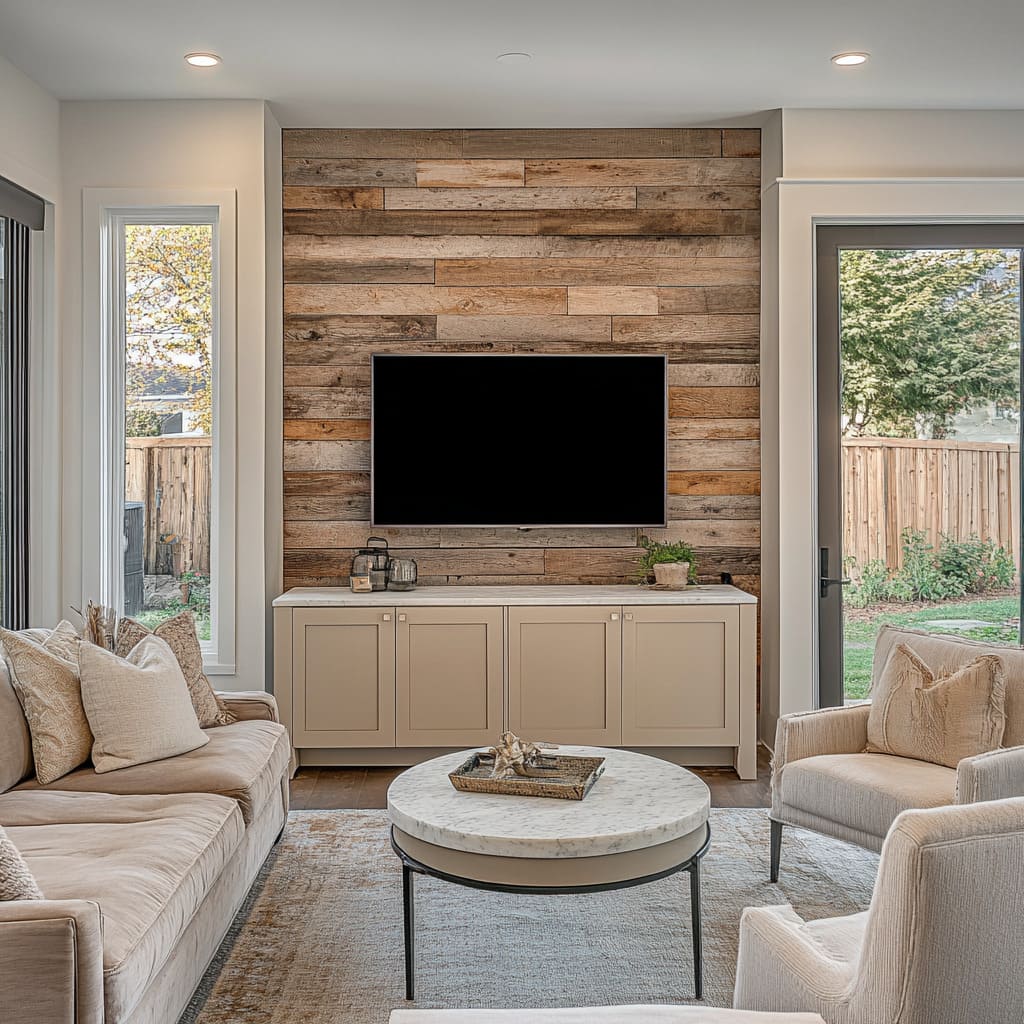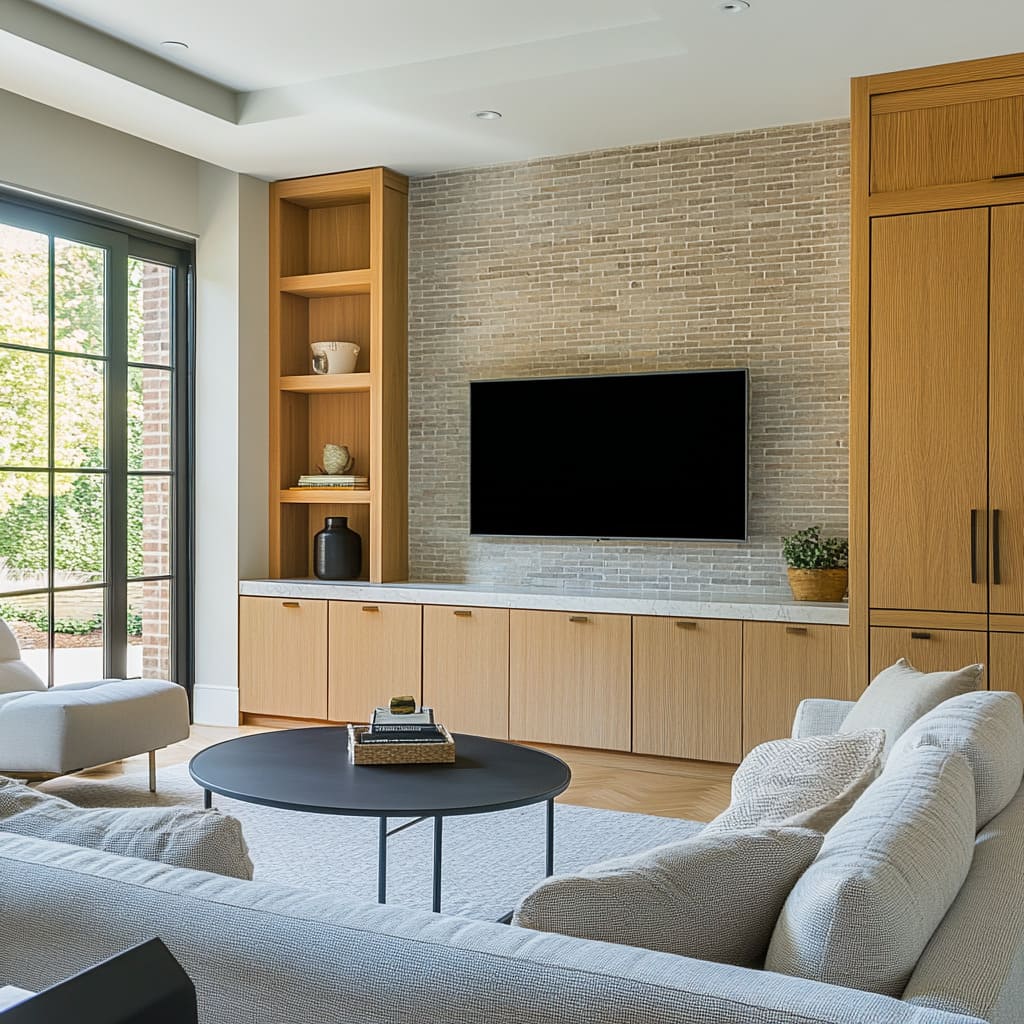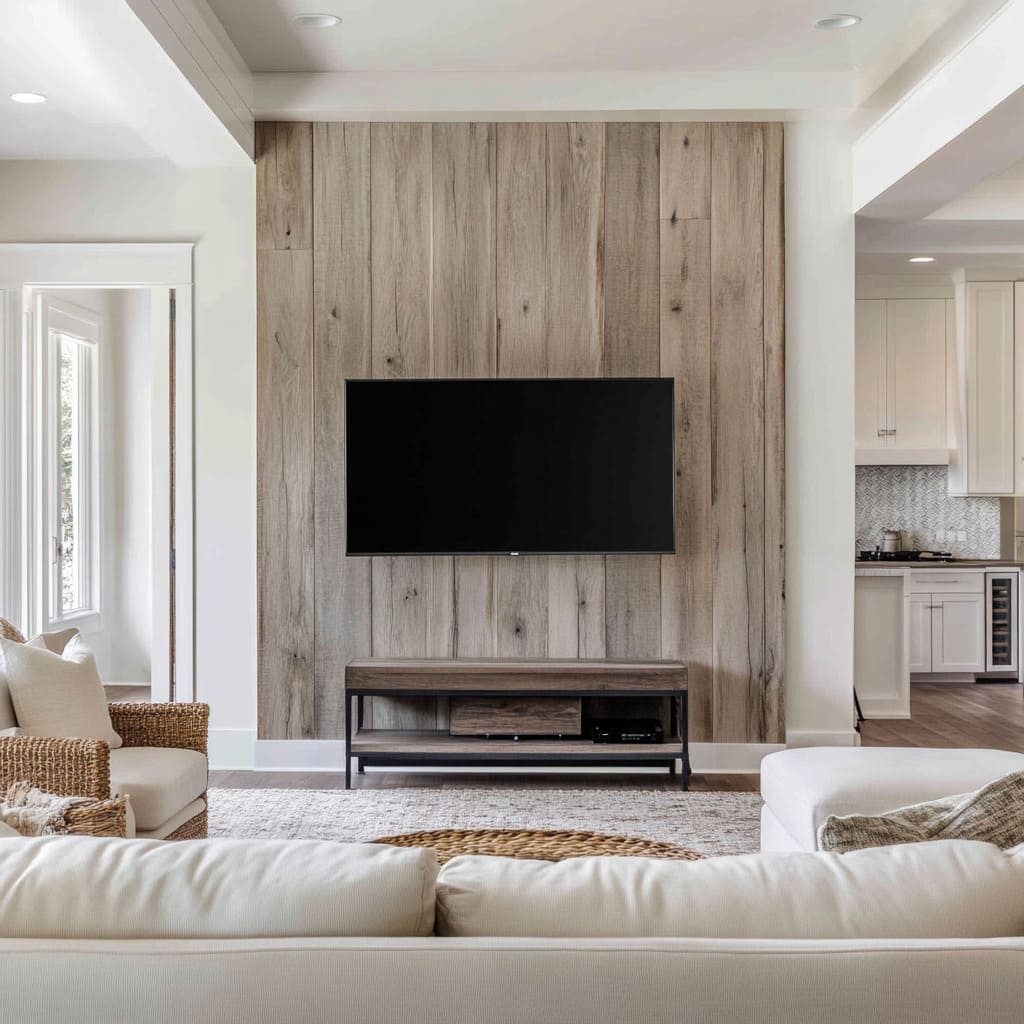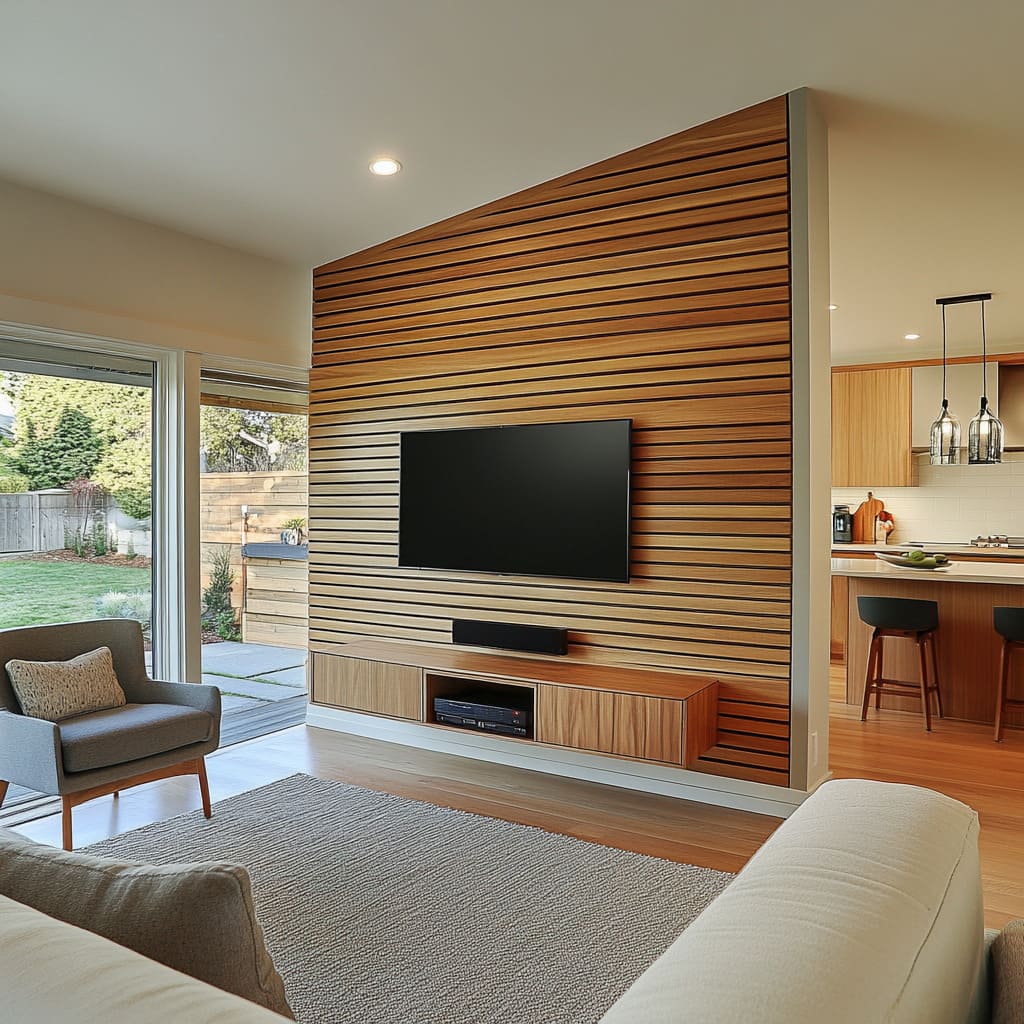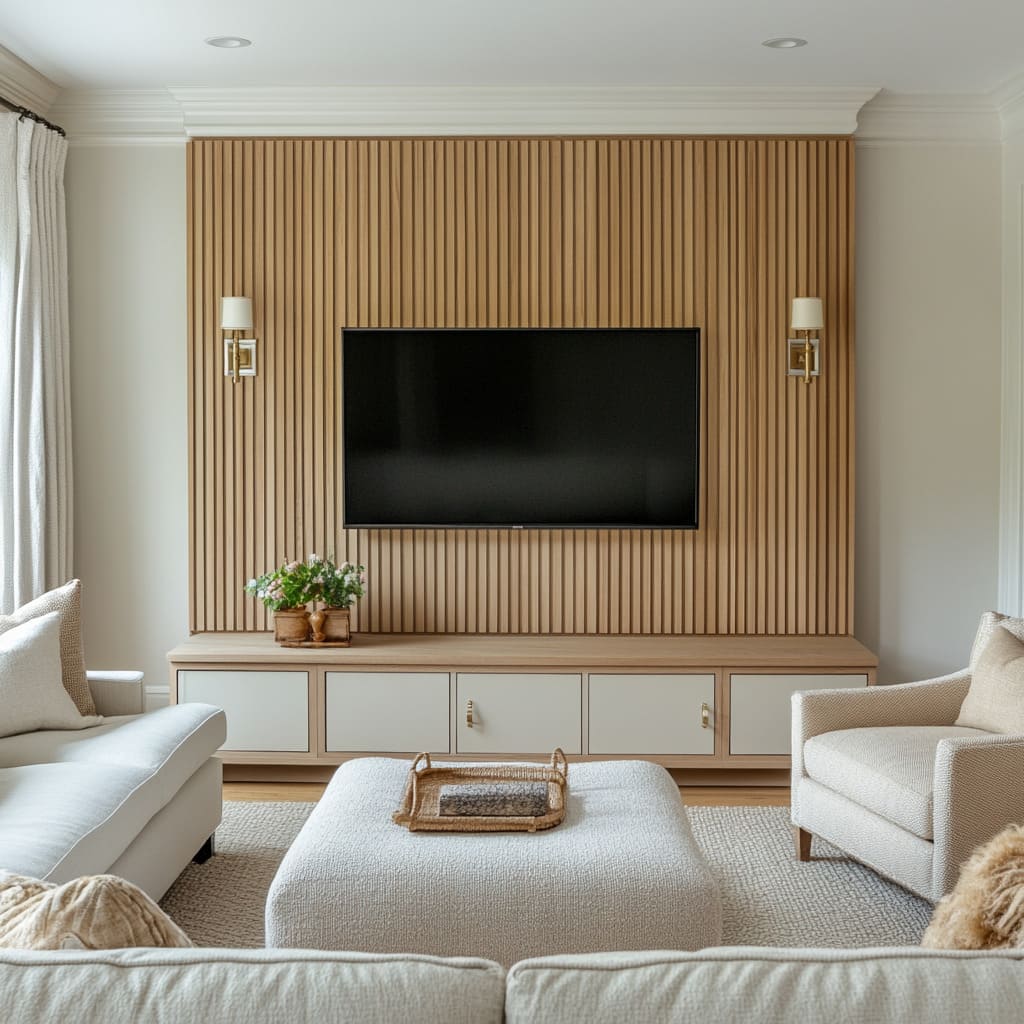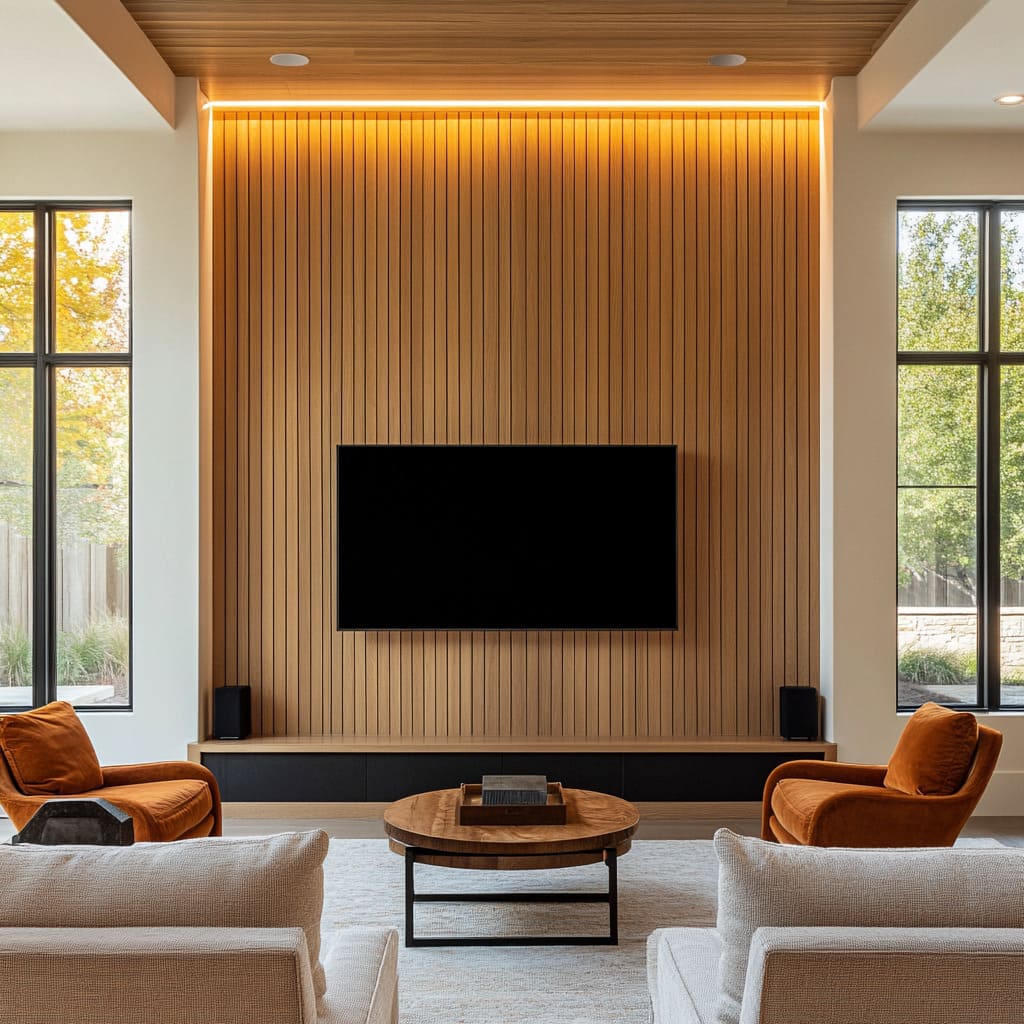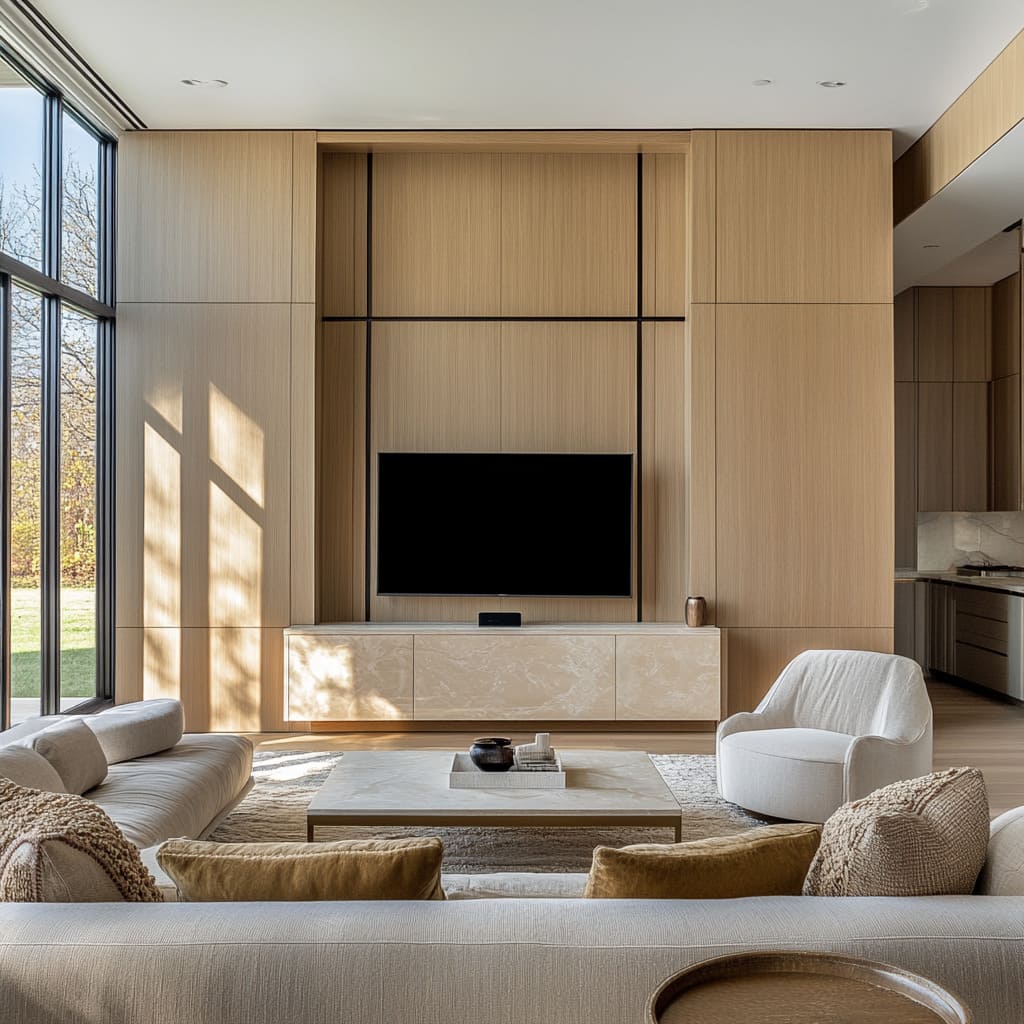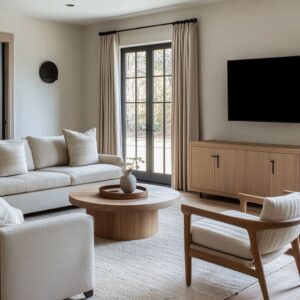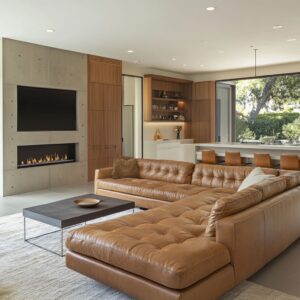A wood accent wall behind tv has quickly become one of the most recognizable design features in modern living rooms. But beyond the surface, there’s a lot going on that’s easy to overlook.
These walls are no longer just a spot to hang the screen—they’ve evolved into architectural elements that shape the mood, balance the layout, and frame the technology without letting it dominate. This article looks deeper than color palettes and wood types.
It breaks down the subtle design moves—hidden lighting, quiet symmetry, acoustic texture, and smart millwork choices—that make these walls feel natural yet precise. Whether the style leans warm and rustic or clean and modern, each version shares a common goal: bringing harmony between materials, function, and space.
Layered Depth and Subtle Shadow Play
A well-built wood accent wall with a TV doesn’t depend on flashy elements to stand out—it earns attention through the quiet detail of how it plays with depth. Many designers have embraced shadow gaps as an intentional feature.
These narrow spaces between wood slats, whether running vertically or horizontally, create a shifting pattern of light and dark throughout the day. Even a gap as small as a few millimeters can carve out a sense of movement, especially when enhanced by ceiling lights or sunlight filtering through nearby windows.
Another detail that adds depth comes from how the edges of the panels are shaped. Instead of flat cuts, some walls use rounded or beveled edges.
This subtle curve changes how light hits the surface, creating more pronounced shadows that give even a thin board an impression of sculptural weight. In some homes, the layout goes even further.
The wall might be recessed slightly where the TV sits, or the panel might push out to form a visual break between living areas. These shallow alcoves or projections are rarely noticed right away, but they work quietly to add rhythm and depth to the layout.
The result is a layered look that never feels forced—each shift in the surface helps guide the eye naturally.
Purposeful Alignment and Proportion
There’s a certain calm in seeing a space where everything lines up as if it belongs there. That’s especially true with a tv wall wooden design, where the direction of the boards and the placement of the screen make a big difference in how the room feels.
Vertical slats tend to stretch the space upward, making the ceiling seem higher—this works especially well in living rooms that need a bit of height. Horizontal boards, on the other hand, can visually widen the space, a smart move in smaller or lower-ceiling homes.
Placement matters too. Many interiors position the television so that it aligns perfectly with panel seams or trim lines.
This isn’t only about neatness—it helps the whole composition feel intentional. When the TV sits dead center, anchored by lines in the paneling or floating above a console that matches the wall’s grain, the room immediately feels more grounded.
Scale plays a big role as well. In rooms where the wood has a strong texture or thick pattern, designers often pull back on everything else—neutral upholstery, clean-lined furniture, and minimal décor keep the focus where it belongs.
On the flip side, a simple wall with evenly toned wood panels can handle a splash of color or bolder shapes nearby without losing its visual weight. The balance keeps the room from tipping too far in any direction.
Subtleties of Wood Species and Grain Selection
Not all wood panels tell the same story. A closer look at high-end living room tv wall wood design reveals a level of precision many might miss at first glance.
One of the most refined techniques is book-matching, where each veneer sheet is cut in sequence from the same log and laid out like mirrored pages. This creates graceful, almost wave-like movements across the surface.
In some homes, it results in a symmetry so clean it looks like the wall grew into place rather than being installed.
Another subtle trick lies in mixing different cuts of the same wood species. For example, rift-sawn oak, known for its clean vertical grain, might be used for central panels, while surrounding areas might feature flat-sawn boards with a bit more personality in their curves.
This keeps everything in the same tone range but adds texture and variety that reads as quiet luxury rather than contrast. And then there’s character wood—boards with knots, light imperfections, or weathering.
These aren’t flaws. They’re chosen on purpose, especially in spaces with modern furniture where something a little rugged helps soften the edges.
A reclaimed plank wall, for instance, instantly adds warmth without disrupting the calm of a minimalist layout.
Strategies for Concealing Technology
Clean lines and invisible tech are key elements behind some of the best wood tv wall ideas. The television is no longer treated like a separate object—it’s built into the wall plan, often flush-mounted with no brackets in sight.
Cables and devices are hidden behind the panels through pre-planned channels or hollow spaces, allowing the screen to appear weightless and part of the structure.
Audio equipment also follows this approach. Soundbars or speakers are often coordinated with the wood’s color and grain.
If the wall has vertical slats, the speakers might be placed between them or matched in finish to blend in completely. Horizontal components, like slim soundbars, can disappear into gaps just below the screen without interrupting the layout.
To keep things neat below, many setups include floating cabinets that ditch handles in favor of push-to-open fronts. These pieces hold all the practical gear—remotes, routers, gaming consoles—without showing any of it.
The visual result? A living space that feels clean, smart, and far from cluttered.
Lighting as a Sculptural Component
The right lighting can do more than just brighten a space—it can shape how we read the surface of a modern tv wall design wood feature. One technique seen often in refined interiors is the use of recessed ceiling lights aimed close to the wall.
These aren’t your standard overhead bulbs. Placed precisely, they graze the wood with a soft wash that brings out textures like fluted ridges, subtle carvings, or natural wood grain shifts.
The effect changes throughout the day, especially in rooms that get a mix of artificial and natural light.
Another approach comes through hidden light sources—especially strip lighting. These are often tucked into ceiling coves or built discreetly behind consoles and shelves.
The glow they create outlines the shape of the wall without casting harsh shadows or showing the fixture itself. It’s an understated way to bring dimension to flat wood or to emphasize patterns without being showy.
Wall sconces, when used well, also do more than add brightness. They help establish rhythm.
Whether it’s sleek black cylinders in a modern setup or aged brass arms in a more traditional layout, the symmetry of their placement flanking the TV creates visual balance. This small move adds formality and intention, especially when matched to the room’s overall style.
Their light works as a framing element, spotlighting the wall without overwhelming it.
Nuances of Color and Texture Harmony
Pulling off tv wood panel design ideas that feel cohesive requires a lot of subtle planning—especially in how colors and textures interact. Wood on the wall can be a strong visual element, so the rest of the room often needs to take a step back.
One way designers do this is by choosing flooring that contrasts in direction or tone. If the TV wall features slim vertical oak panels, the floor might go with wider planks running horizontally.
Even when the tones match, the shift in orientation helps each surface hold its own without blending too much.
Textiles and furniture also play their part. Pale neutrals like ivory, greige, and oat show up a lot for good reason—they frame the wood without competing with it.
If color is added, it’s usually through one strong element: maybe a deep green velvet chair, a terracotta cushion, or a warm-toned rug. These accents work best when they echo something in the wood—like its undertone or texture—so the room feels calm and connected.
Materials like marble and metal offer contrast without stealing the spotlight. A black or brass trim around a console or panel edge helps define lines, especially in more structured designs.
Marble, particularly when used on tables or cabinetry tops, adds a cool, polished touch that complements the natural feel of the wood. It’s this play between texture and temperature—grain against smooth, warm against cool—that makes the room feel layered without ever looking too busy.
Architectural Continuity and Integration
Some of the most visually satisfying tv panel wooden design installations go beyond the wall itself—they extend across ceilings, corners, and connecting surfaces. In rooms where the same wood finish runs up the wall and across the ceiling, the effect is immersive.
This wraparound look feels complete without being overpowering, especially when the ceiling boards shift direction to avoid monotony. That perpendicular alignment helps break up the pattern just enough to give structure without losing unity.
Framing plays a big role too, especially in homes that borrow from classic architectural styles. Vertical pilasters, crown molding, or thick base trims in either matching or contrasting finishes can turn a flat wall into something that feels purpose-built.
In more modern settings, thin black framing or edge detailing outlines the panels cleanly and adds definition—especially effective when the wood grain is subtle.
Curves bring a completely different energy. A curved wood feature wall, especially using thin tambour strips or narrow slats, creates motion and softness where straight lines might feel too rigid.
These curved applications are technically challenging but worth it—making a corner of the room feel like a sculptural feature instead of just a boundary.
Psychological and Functional Dimensions
A thoughtful pallet wall behind tv doesn’t just look warm—it often makes the room sound better too. Wood slats with small gaps, paired with soft backings or hidden acoustic material, help control sound in open-plan living spaces.
Even if no one labels them acoustic panels, the benefit is noticeable—dialogue on the TV becomes clearer, and echoes are softened. Beyond sound, wood adds balance.
In homes that lean heavy on glass, concrete, or metal, natural grain adds the missing softness. It brings in a layer of texture that tempers the sharper elements.
This is especially useful in modern or transitional interiors where the goal is to make the room feel welcoming without clutter.
Using reclaimed or lightly distressed planks also introduces a different kind of story. Small imperfections—like nail holes, knots, or worn grain—add character without looking forced.
They break the polish just enough to give the space depth. And in a well-planned layout, those aged boards still follow a visual rhythm, offering richness without chaos.
It’s that quiet contrast—old wood against new tech—that often makes the whole room click.
Key Themes and Patterns
Across every standout tv wood wall design, a few shared patterns keep showing up—each one helping shape both the function and the look of the space. One of the biggest shifts is how hidden the tech has become.
Wires disappear into walls, brackets vanish, and even cabinets go without visible handles. This quiet approach turns the TV into part of the structure, not a bolt-on piece.
The focus stays on material and proportion, not equipment.
Another detail that makes these walls work is how precisely the panels meet. Whether the wall features bold vertical slats or wide horizontal boards, the joints are tight and seamless.
Poor alignment would be impossible to ignore in these clean, minimal layouts—so careful installation is everything. There’s also a clear move away from contrast-heavy color palettes.
These rooms favor tone-on-tone combinations: soft wood against warm upholstery, light rugs, and calm wall colors. The wood gets to lead, not fight with other elements.
Lighting adds another layer. Designers often use a mix of recessed spotlights, hidden LED strips, and subtle sconces to bring out the grain and shape of the wall.
No single source stands out—the combined effect is a soft, steady glow that supports the rest of the space. Lastly, there’s the quiet echo of structure.
Whether it’s repeating lines from beams, or how the slats line up with window grids, these walls often mirror other parts of the room. That subtle repetition ties everything together without shouting for attention.
Concluding Insights
What looks like a simple wood wall behind a screen is usually anything but. Behind that clean finish is a series of carefully thought-through moves—how each board flows into the next, how the light hits, where the seams land, and how the TV sits within the overall frame.
These aren’t quick fixes or filler walls. They’re part of the architectural language of the room.
From curves to flat panels, reclaimed timber to book-matched oak, the range of approaches reflects how versatile these walls have become. And with tech fully integrated and lighting woven in, they now do more than hold a screen—they define the atmosphere.
A well-executed wood accent wall isn’t just background anymore. It becomes the backbone of the space, a calm anchor that holds the layout, tones, and textures together in a way that feels both effortless and considered.
